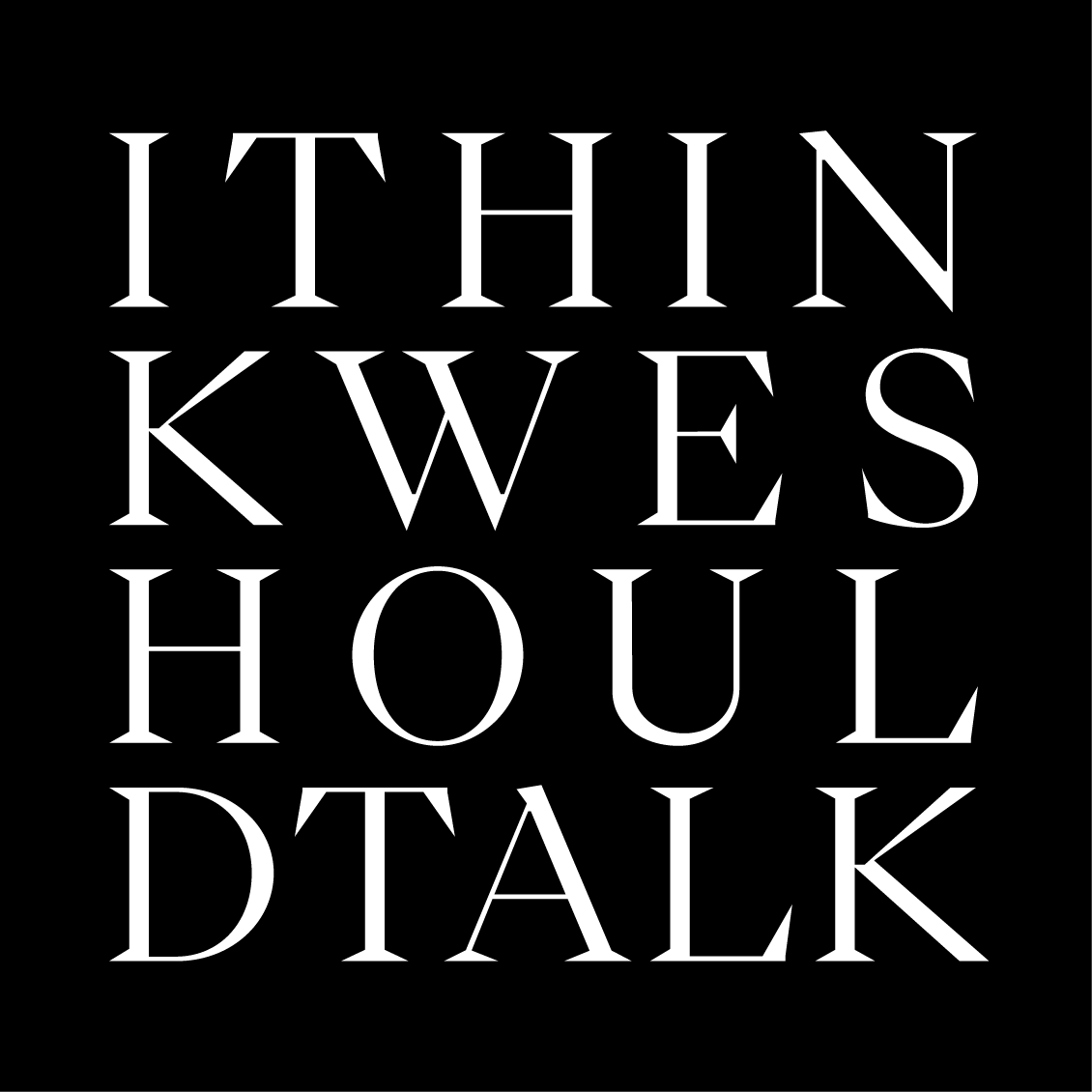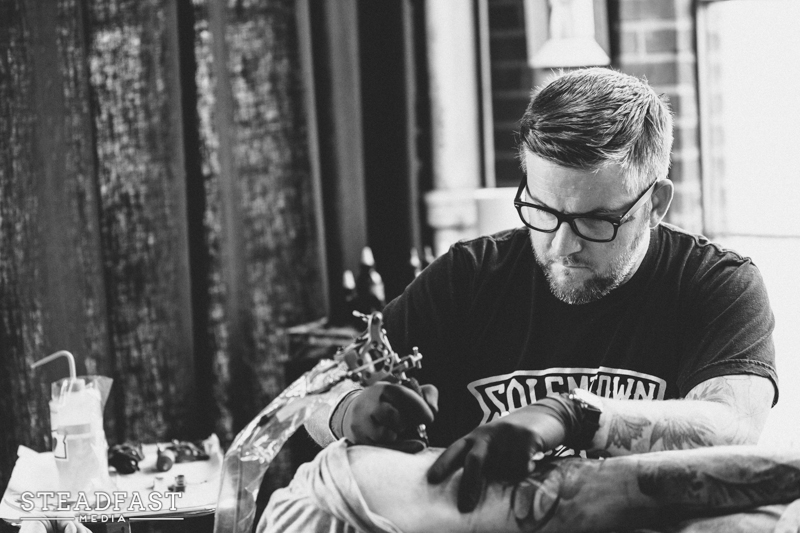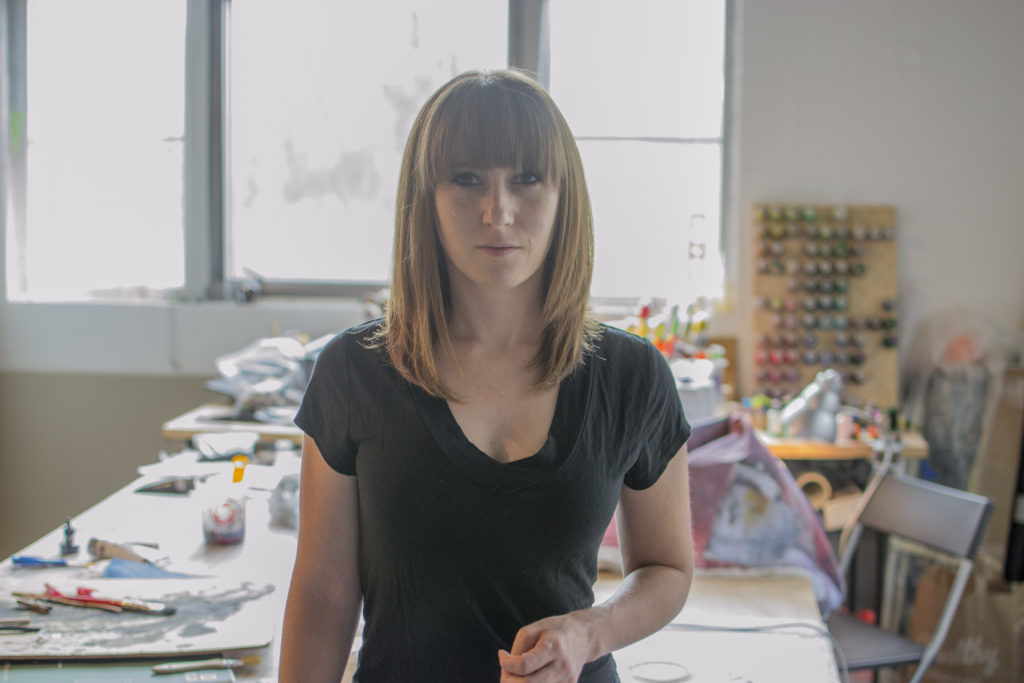Ian White —
In 2010, I met Ian White in Nashville while getting tattooed. We immediately started talking about philosophy, documentaries, business, and life. (We also share a birthday.) Our conversation about the process of becoming the “inspiration for,” not simply the “master of” your craft through meditation, recovery, and being the best human you can be shows us that the process is never really complete.
Paul
As a visual artist and tattoo artist, what about your process makes it unique to you and what you do?
Ian
What makes it unique to me I think has been something that’s been honed over the years. Like actually trimming down what I do. I think the aspect of ‘I only do black and gray’ has me working within a scope that I feel really comfortable in. I’m capable of many many forms, and I could probably please the masses if I wanted, but I think that something I’ve realized, really over the last year—I just passed eleven years of tattooing and I feel like I’m just starting—and I’m realizing that if I can figure out a way to make this tattoo for me, the client gets the benefit. The more I can make this tattoo pleasing to me, the more it’s going to be the best thing I’m capable of doing. With my process, that has sort of become my beginning point.
Paul
I like this aspect of moving things out of the way, focusing on a really narrow aspect and being really good at that.
Ian
Yeah, I could punch the clock and do all the different things if I wanted, but it’s not what makes me happy. The happier I am, the better the product I’m putting out. It’s odd but cool to only just now be coming to a realization of that.
There’s nothing necessarily new under the sun, but nobody looked at the shadow side.
Paul
Where do you think the next eleven years are going to go?
Ian
Hopefully bigger projects. I think I’m in the infant stages of working toward having most of my catalog being full backs, full torsos, full arms, full legs. I get more freedom in that. And it’s not that I don’t still enjoy some of the smaller pieces, I’d rather get really good at the large scale ‘whoa!’ pieces. Pieces that when someone sees it they wonder what to say about it. If anything at all. I think even more, the biggest compliment would be to strike somebody speechless. Even for myself, to sit back and think ‘man, that was a pleasurable experience to create,’ for me, the larger pieces are that. So the next eleven years, it’s actually tattooing less, but tattooing more specific. More specific than I already am.
Paul
Tell me a little about how painting influences the way you tattoo and vice versa—how tattooing influences the way you paint.
Ian
It’s been career-changing, now that I’m painting. It’s changed my artistic outlook. It’s changed how I approach a tattoo. How I approach flow. How I approach layering. But it’s also given me confidence in some of the things I was already doing fairly well. Then to study the painting from masters and go ‘Oh, ok that’s the thing I was already doing,’ and I can get better at it because I can name it. Like ‘Value Studies.’ Or ‘Contrast.’ Things like that I was already doing pretty well. It’s real essential in black and gray and now that I can give it a name, I can get even better at it.
The other part too is that now I have another avenue to practice and to be more creative. With tattooing, even if it is a tattoo for me that I’m trying to make it for me, I heard someone once say ‘think of what you’d want tattooed on you, and tattoo that on people.’ I’m getting to do that in painting. I’m getting to think of something and create it with no risk. The worst risk is that I just paint over it again. But I’m able to pull out those thoughts because I get more and more people that are like ‘what do you want to do?’ As a tattooer, you’re always reliant (for the most part, until you become a master) on someone who comes to you and says ‘I want a skull with a flower and a knife’ and you go ‘Ok cool, I can work with that.’ When they say ‘Just do anything’ my first reaction is ‘Ok, a skull.’ I want to broaden to more than just a skull. And painting helps me do that.
There are the guys who teach painting and they’re who you want to paint like. Maybe DaVinci or Michaelangelo. But then there’s the one step past that and those are the ones who inspire: ‘A true artist is not one who is inspired, but one who inspires others.’
Paul
What do you think after painting is going to be the next career-changing thing for you? It’s hard to look that far into the future, but this has probably given you some perspective on that.
Ian
It has. It actually gave me some confidence in it too. I recently went through and scheduled and went and did a guest artist position at Off the Map Tattoo in Massachusetts. And through that, I was able to get the foot in the door with a company and a collective that is very inspiring to me. And through that, I was scheduled to go out to their northeast location, which is where my favorite artist works. My next process is to get myself around the people that I admire. Whether it’s flying to LA to take a painting class from Steve Houston, getting to go do a guest spot in Oregon with Jeff Gogue, or whatever it might take. Those are the things that are my next steps; trying to bring up my painting and tattooing side-by-side. They definitely help each other.
Paul
What about anything 3D? Sculpture? There are so many things you could do.
Ian
I’ve always had a love for sculpture. I actually went into this little art gallery in Leipers Fork and there’s been a few bronze castings a guy has, and I can’t stop thinking about them. I look at it and I’m impressed by it, and I think ‘You know, I could do that.’ With study and practice, it’s do-able, especially taking in information from people who do it better. I think it would be a lot of fun. Still life as opposed to reference in painting, working from life is recommended, as opposed to photo reference. Being able to sculpt something you can completely walk around is neat, and it gives you a whole different attribute to your mental rolodex for reference.
Guy Aitchison was well-known for it. He would do these bio-organic pieces and he would sculpt them. Then take that sculpture and photograph it with different light sources on it. Then photograph that and use it as a reference. And sometimes the client would get to take it home when it was all done.
Sculpting is something that’s being taught more at these artist retreats for tattooers. It was something I’d only heard of the one time, but I’m actually very interested. I see these photos from the retreats and they’re doing sculptures of weird faces and skulls and it’s gotta be helpful in some way.
The happier I am, the better the product I’m putting out. It’s odd but cool to only just now be coming to a realization of that.
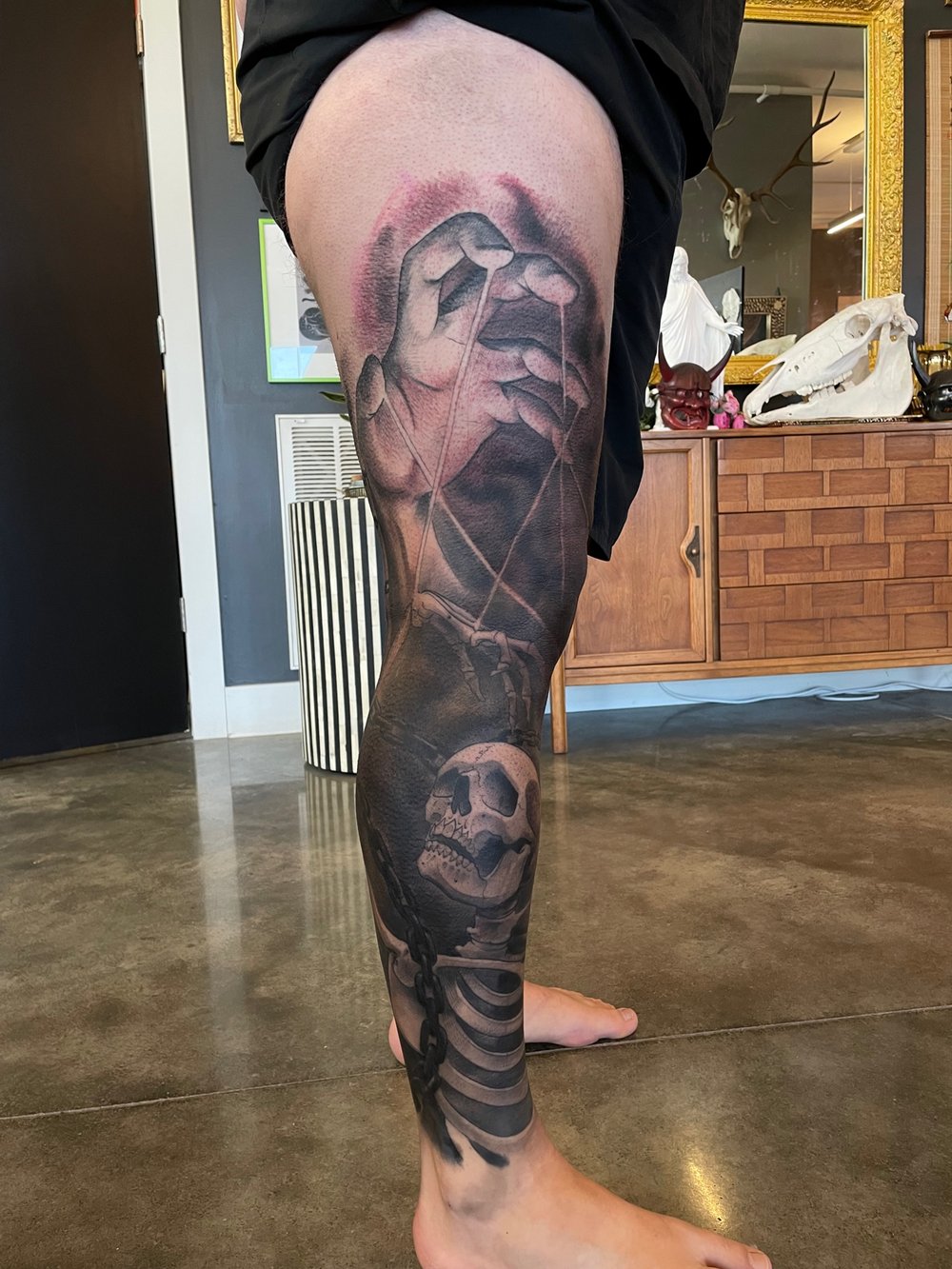


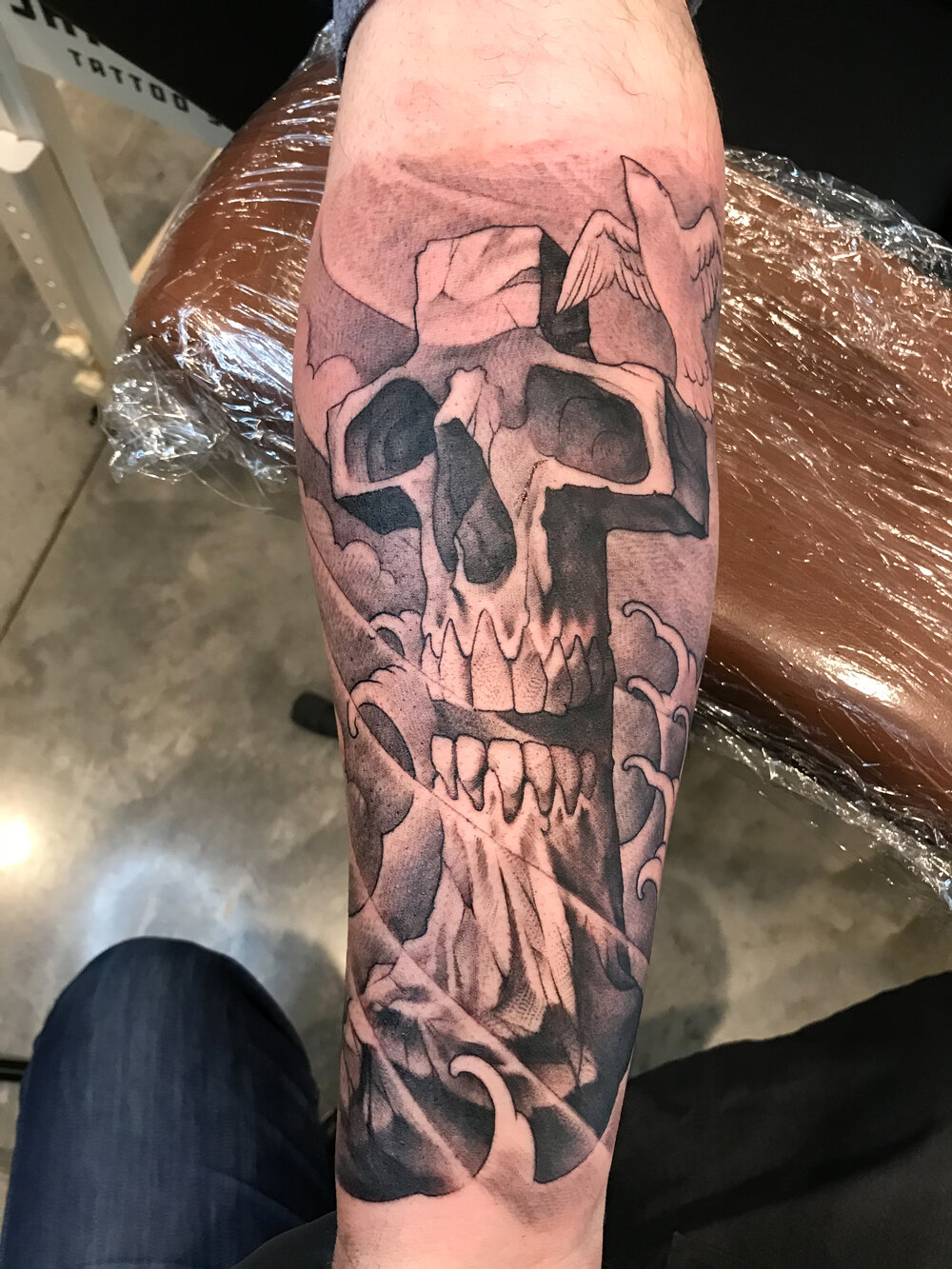
Paul
So how do you see your process driving the future of your craft?
Ian
I got to a point where my process is less about the execution of the art, and more about all of the other stuff. I think it used to be those hours that I was doing a tattoo, that was what it was all about. Now I’m learning more and more that the process, all leading up to it is becoming so much more vital and exciting. Because I can take it and spend time by myself with it. And tattooing is a rare craft where we sit with the client the entirety of the project. Painters don’t do that. Maybe if they’re painting that person. That’s the only other time and they probably want them to sit perfectly still and not talk. But with us, a lot of the creative process starts with them there, so you have to start your process earlier and have time, like meditation with it before I ever sit with a client. It’s improving on things.
Paul
Let’s go to meditation. I know you’re a very spiritual person. Does that factor in to your process at all?
Ian
It doesn’t factor in as much as I would like it to. It’s something that I really feel would be very good for my whole process, and my whole life and outlook. It’s something I’m working on. But it’s nowhere near, not even in the ballpark, of where I’d like for it to be.
Paul
Where would you like it to be?
Ian
Daily. Where I’m at, I’m a husband, a painter, a tattooer, a leader, a business owner, sort of a mentor. Take all those and be able to sit and meditate on them individually would help me give each one of those my utmost attention. I have a tendency to wear all the hats, all the time. And it’s no good for anybody.
My wife is so supportive of my process and my career. If I need time to figure it out, or I’m agitated, she can give me the space to work through it or be there. With all if it, I don’t think I’d be able to get as far as I have without her in my life.
Paul
You and your wife did the Camino de Santigo together. What did you learn there?
Ian
Simplifying my day. Simplifying my thoughts. When you’re on the Camino, there’s only one real major decision you have to make every day, and that’s ‘Am I going to get up and do it again?’ Every day. Your feet hurt. You’re wondering what you’re going to eat that day and if it’s going to be good. You don’t go hungry. There’s food. Is it going to be hot? Is it going to rain? All you have to do is say ‘I’m going to just go today.’ And all the other decisions happen throughout the day.
That aspect of ‘Today, I need to just get up and go and the day will happen.’ I’ve done this so much that I should just trust my instincts and I’ll take care of myself. I’ll feed myself. I will interact with my wife and my clients and the people at work. It doesn’t have to be a super thought-out thing, like ‘How will I interact? How will I do this?’ Just put one foot in front of the other.
There’s so much time for thought on the trip. There’s time when it’s just boredom and you go ‘Well, I’ve thought of everything I can think about.’ Which is never true. There were really great times of introspection and internal questioning and external questioning and spiritual and philosophical questioning. ‘What does it all mean?’ You get the time to go through all that, and then even be so long with it that you answer your own questions you have enough quiet time for God to give you the answer.
That’s kind of what meditation looks like for me. I don’t think it’s sitting still in a chair. I think that’s great, and I wish it could be my meditation sometimes, but going for a trial run and making sure I maintain doing that. Or making sure I exercise. Or going for a walk. Those are the meditations I accidentally did for thirty-two days of walking. I think it affected me in a way that I’m grateful I’m still holding on to while I’m home. My one fear on the Camino is that the Camino would be for naught. I would learn a lot of things and grow and experience things, but I’d just come back and go back to the old way of how I went to the grindstone and do things the same way.
I feel like it wasn’t for naught. There are a lot of aspects I’m still carrying with me. And I can feel my body pulling in ways like ‘Oh but you could just get anxious today, that would be more fun, right?’ But instead I can sit and say ‘That’s not what I want to do today.’
Tattooing is a rare craft where we sit with the client the entirety of the project. Painters don’t do that. Maybe if they’re painting that person. That’s the only other time and they probably want them to sit perfectly still and not talk. But with us, a lot of the creative process starts with them there, so you have to start your process earlier and have time, like meditation with it…
Paul
Were you thinking about process at all on the Camino? Sketching?
Ian
I had all kinds of thoughts of things I would do, and I did about none of them. I didn’t sketch. I did one doodle of a bridge and it was a nice serene moment. I was going to go journal but I drew the bridge instead. That was the only drawing I did the whole time I was there.
I think even just not thinking about all that for a month was good. I’ve got awesome guys at the shop so I didn’t think about the shop. As far as my art, I’d see things and get pictures of them and think ‘I’m going to paint that later.’ I think I got more into ‘How do I take better care of myself, to be better fit to paint, and be a husband, and be a shop owner, and be a better artist.' That’s more of what I brought with me. It was not what I thought. Anything I thought I would do while I was there was not done. And better things came.
It wasn’t all puppies and rainbows. Physically, there were a lot of hard times. Spiritually, there were hard times. My wife and I got into a fight! I was being a dick and she called a dick in the middle of a coffee shop. It was such a great moment in the middle of this trip when I thought I was being so spiritual and really, I was being a dick. It was out of being co-dependent toward the people around me and not taking into account my wife and her feelings. And from that point on, the trip was way better and way better with her. It was a learning process, and sometimes not always a touchy/feely one. Sometimes it was a two-by-four across the head. But it was still wonderful.
I am a person who is living their dream. It wasn’t a real laid out awesome path, but all the little bumps in the road have made it how great it is now. I grew up in Oregon, joined the military, moved to Ohio, spent a lot of time there and started tattooing there. I moved to Nashville and it’s been since then that things have really exploded for me. Not just having more clients, but exploded with what I provide to my clients. I see it as a constant journey.
I was listening to this one artist I respect a lot and he was talking about going to the Salvador Dali museum, and there was a quote in it. You have masters in painting. There are the guys who teach painting and they’re who you want to paint like. Maybe DaVinci or Michaelangelo. But then there’s the one step past that and those are the ones who inspire: ’A true artist is not one who is inspired, but one who inspires others.’
Ultimately that’s what I hope. It’s really a position that anybody can be in. Even if that’s one day I’m not tattooing but I’m inspiring others. If more people were doing what they loved for a living, it would change the world. The world would literally be a different place. There’s somebody who loved being a garbageman. If you’re doing it just because you have to, you need to be doing something else.
Tattooing is just an aspect of what I do. It pays my bills and I’m super blessed for that. Learning more how to paint, maybe that inspires someone. I’ve been tattooing for eleven years and I’m just a freshman at painting. I’m a person who is in recovery and have been for a couple of years now. I’ve had sobriety for quite a while now and it’s of God’s grace and the people around me. Maybe that can be inspiring to somebody.
I realized at an early age, human beings are just naturally not content. It’s a defense mechanism that’s put in us that makes us want to wake up and keep living.
Paul
How does that influence your process and what you do every single day?
Ian
Recovery? It does. There’s something about the twelve steps. If I’m agitated I can go ‘Ok, which one of these steps is throwing me for a loop?’ And I can step back and realize it’s not them. It’s that I need to make an apology to them. It’s really helped me get things back more quickly.
It fosters intimacy between me and my staff. To be able to go to someone and say ‘This is bugging me today and I need to get it off my chest. I don’t need you to say anything, I just need you to hear it.’ And they appreciate that I trust them with that. I’m in a unique position because I’m the boss, but these guys are four of my best friends. I always have somebody I can talk to about something. We have a really good, open, safe place there.
Learning how important the process is has made me more excited about tattooing again. When you do what you love every day, you have to figure out ways to keep it what you love. I feel like I’m back on the horse of really loving it. I’ve always had a few select clients that are like ‘man, thank God for that guy’ because they’ve kept me in the game of loving it, yourself included. But now I’m able to make it more of ‘I get to do that today.’
You ask any tattooer of ten or eleven years and they’ve gone through those highs and lows and I feel like I’m swooping up what is the beginning of my career, as opposed to the next step. Really, this is ten years of learning to tattoo. Now I can do what it is I want to do with it. Process is the main part. That’s really the thing that’s exciting about it. Learning more about my process. How does it grow? I didn’t really know the word for it until I saw your questions. It is the thing that’s so important.
Paul
Where do you find the most inspiration?
Ian
I think mostly just the world around me. I like smashing different thing together. I learned how to draw people by reading comic books as a kid. I’ve always loved comic book art. Taking that and master painters and finding out they had a background in comic books. It’s kind of an interesting thing. I’m always striving to be creative. In tattooing, it’s difficult. How do you do that differently? How do you work your style into it and make people go ‘That was an Ian White.’ The more I tried to make it do that, the less it was me doing it. The more I’ve done it, the more it looks like I did it.
I hope my drive is unique. I hope the experience you get while being tattooed by me is unique. Sometimes it’s an unfortunate experience that’s unique. You hear about it a lot in our industry. ‘Yeah, it was so-so. I got this cool tattoo but the guy was kind of a jerk.’ I’m hoping I can bring the whole package. And not just to bring it, but to be myself and they get an experience.
Inspirationally, I’m finding it in more and more places. I used to think it had to be something like ‘I’ll go to a museum and look at this thing’ and that’s my inspiration. But I think it’s conversation. That’s my inspiration. Scripturally. There’s this painting in the Old Testament that’s been done by all the masters. How do I do it differently? I’m trying to do the conversion of Saul on the road to Damascus and I want to try and do it in a way that I’ve never seen it before. I have a painting of the back of a skull that Gogue did, and I bought it because nobody paints the back of a skull. Why would anybody buy the painting of the back of a skull? And I bought it because that’s what I needed hanging in my booth to inspire me to look at things from a different angle. There’s nothing necessarily new under the sun, but nobody looked at the shadow side.
